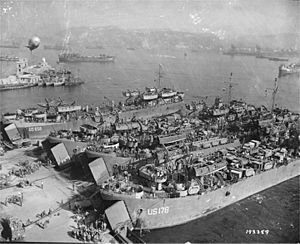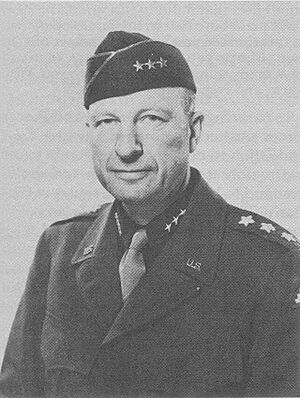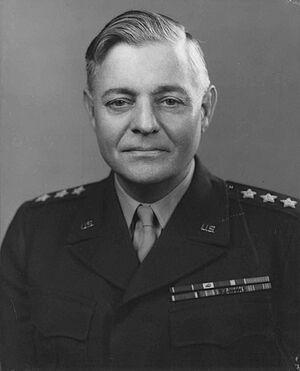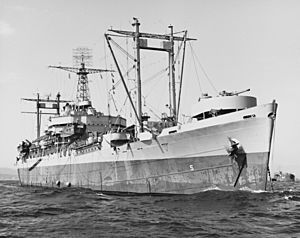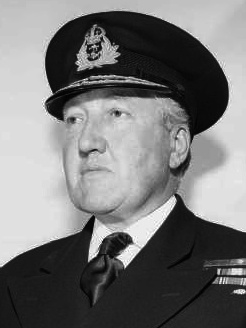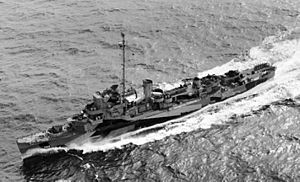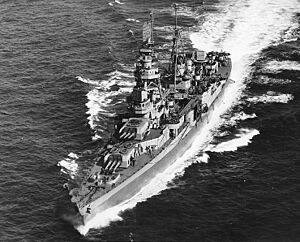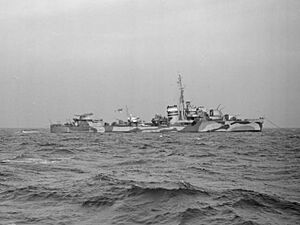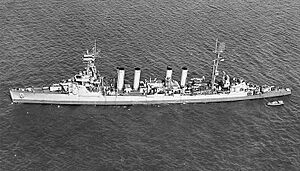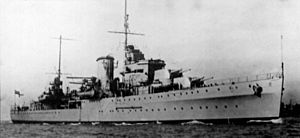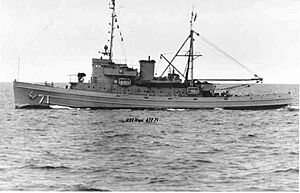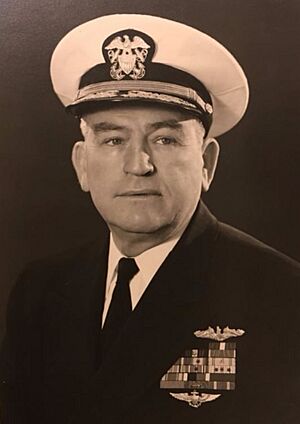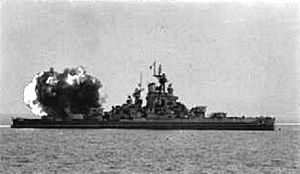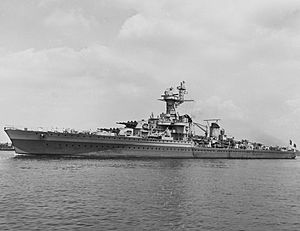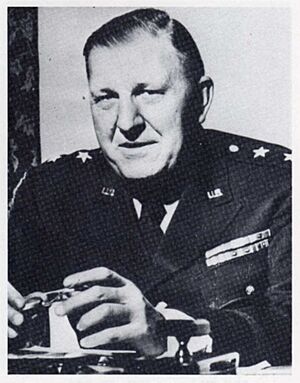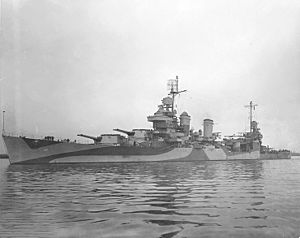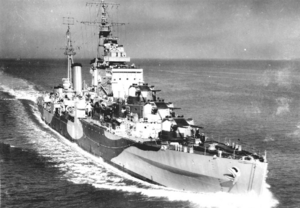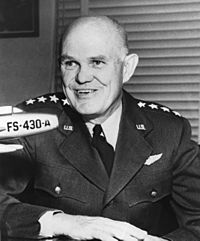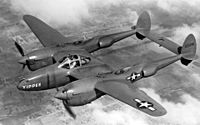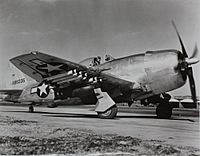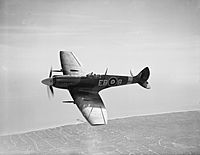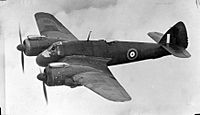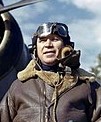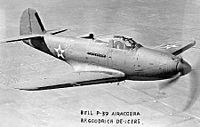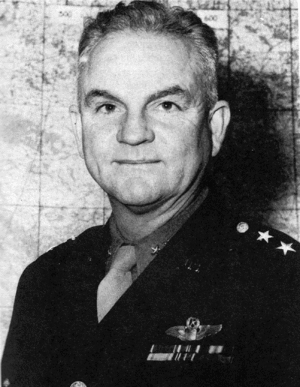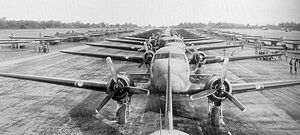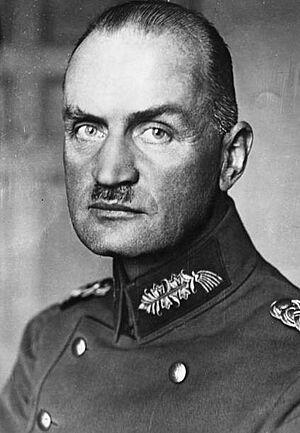Operation Dragoon order of battle facts for kids
On August 15, 1944, during World War II, Allied forces launched a big attack called Operation Dragoon. This involved soldiers landing from ships along the Mediterranean coast of France. Three US army groups landed first, followed by four Free French army groups. Before the main landings, paratroopers jumped from planes at night, and special commando teams landed on the beaches. This was an important part of the war in Europe.
This operation was first called Operation Anvil. It was supposed to happen at the same time as the famous Normandy landings (D-Day). But it was delayed because all the ships were needed for D-Day.
British Prime Minister Winston Churchill didn't want this invasion in Southern France. He thought it would be better to attack in the Adriatic Sea. However, the American leaders, especially General Dwight D. Eisenhower, really wanted a port on the Southern French coast. The ports used after D-Day in Normandy were too busy. A new, large port closer to Germany was needed to bring in more soldiers and supplies. Also, the French Liberation Army wanted to land in Provence because they had many trained French troops ready. Churchill finally agreed just five days before the attack.
In some landing areas, Allied planes and navy ships destroyed German guns or made the soldiers leave them. Only in one area, called the Camel zone, did the landing forces face strong resistance.
The Americans saw Operation Dragoon as a big success. They freed most of Southern France in just four weeks. They also caused heavy losses for the German forces. The important ports of Marseilles and Toulon were soon open and ready to use.
Contents
Who Led the Allied Forces in Operation Dragoon?
This section explains the main leaders and some of the groups that took part in Operation Dragoon.
Allied Ground Forces Leadership
US Seventh Army Commanders
The Seventh United States Army was led by Lieutenant General Alexander McC. Patch. This army had many different units. These included engineers, military police, medical teams, and supply groups.
US VI Corps Leadership
The VI Corps (United States) was led by Major General Lucian K. Truscott, Jr.. This group included three US Infantry Divisions: the 3rd, 45th, and 36th. They also had many support units like artillery, anti-aircraft guns, tanks, and engineers.
French Army "B" Commanders
The French Armee B was the next group to land after the initial forces. It was led by Général d'armée Jean de Lattre de Tassigny. This army included several French divisions, such as the 1st Free French Division and the 1st Armored Division.
US Eighth Fleet Command
The United States Eighth Fleet was commanded by Vice Admiral H. Kent Hewitt. His main ship was the Catoctin. This fleet included many types of ships like destroyers and minesweepers.
Aircraft Carrier Force (Task Force 88)
This important group of aircraft carriers was led by Rear Admiral Thomas Hope Troubridge, from the British Royal Navy. His ship was the light cruiser HMS Royalist. This force had several escort carriers, which carried fighter planes like the Supermarine Seafire and Grumman F6F Hellcat.
Antisubmarine and Convoy Control Group
Captain J.P. Clay led this group. Their job was to protect ships from submarines and manage the convoys. They had many destroyers, destroyer escorts, corvettes, and minesweepers from different Allied countries.
Sitka Force: Paratroopers and Commandos
This force was made up of paratroopers and commandos. They landed during the night of August 14–15, just before the main invasion.
Sitka Parachute and Commando Leaders
Brigadier General Robert T. Frederick led the 1st Airborne Task Force. This group included several US parachute and airborne battalions. It also had the British 2nd Independent Parachute Brigade Group. Special forces like the US-Canadian 1st Special Service Force and French commandos were also part of this group.
Rear Admiral Lyal A. Davidson led the naval support for the Sitka Force. His main ship was the heavy cruiser Augusta. This group provided gunfire support and transported the special forces. It included battleships, cruisers, and destroyers from the US, UK, and France.
Alpha Force: Landings Near St. Tropez
This was one of the main landing groups, hitting the beaches near St. Tropez on August 15.
Alpha Ground Forces Leader
Major General John W. O'Daniel led the 3rd Infantry "Rock of the Marne" Division. This division had its own infantry regiments and artillery battalions. They also had a special Beach Group to help manage the landings and supplies.
Rear Admiral Frank J. Lowry commanded Task Force 84, the naval group for Alpha Force. His flagship was the Coast Guard cutter Duane. This force included many landing craft, transports, and freighters to bring soldiers and equipment ashore. They also had a strong Gunfire Support Group with battleships, cruisers, and destroyers.
Delta Force: Landings Near St. Maxime
This group landed near St. Maxime on August 15.
Delta Ground Forces Leader
Major General William W. Eagles led the 45th Infantry "Thunderbird" Division. Like the 3rd Division, it had its own infantry, artillery, and a Beach Group to help with the landing operations.
Rear Admiral Bertram J. Rodgers commanded Task Force 85 for Delta Force. His flagship was the amphibious force ship Biscayne. This naval force also had many transport ships, landing craft, and a powerful Gunfire Support Group. This group included battleships like the Texas and Nevada, along with cruisers and destroyers from the US and France.
Camel Force: Landings at St. Raphael
This group landed at St. Raphael on August 15. This area saw more German resistance.
Camel Ground Forces Leader
Major General John E. Dahlquist led the 36th Infantry "Arrowhead" Division. This division, like the others, had its own infantry, artillery, and a Beach Group to support the landings.
Rear Admiral Spencer S. Lewis commanded Task Force 87 for Camel Force. His flagship was the attack transport Bayfield. This force also included many transport and cargo ships, as well as a strong Bombardment Group. This group had the battleship Arkansas, heavy cruisers like Tuscaloosa, and light cruisers from the US, UK, and France.
Allied Air Forces Supporting Dragoon
Planes played a huge role in Operation Dragoon, providing air support and protecting the troops.
Mediterranean Allied Tactical Air Force
Major General John K. Cannon was in charge of the overall tactical air operations.
XII Tactical Air Command
Brigadier General Gordon P. Saville led this command. It included many fighter groups flying planes like the Lockheed P-38 Lightning and Republic P-47 Thunderbolt. British and French squadrons also flew Supermarine Spitfires and Bristol Beaufighters. These planes attacked enemy targets and provided air cover.
Mediterranean Allied Coastal Air Force
Air Vice-Marshal Hugh Pughe Lloyd was in charge of coastal air operations. This force used planes like the Bell P-39 Airacobra and Vickers Wellington to patrol the coasts and support naval operations.
Provisional Troop Carrier Air Division
Brigadier General Paul L. Williams led this division. They used many C-47 Skytrain transport planes. These planes were crucial for dropping paratroopers and supplies during the airborne operations.
Axis Forces Facing Operation Dragoon
The German forces defending Southern France were part of Army Group G.
German Army Group G
Generaloberst Johannes Blaskowitz commanded Army Group G.
German Nineteenth Army
General der Infanterie Friedrich Wiese led the Nineteenth Army. This army included several infantry divisions and some reserve divisions. They also had the 11th Panzer Division as a reserve.
German Air Forces
The German air forces in the region were part of 2nd Flieger-Division, under Luftflotte 2.
The German naval forces were led by the Kommandierender Admiral der französische Südküste. They had a small fleet of patrol boats called 6. Sicherungsflotille.


